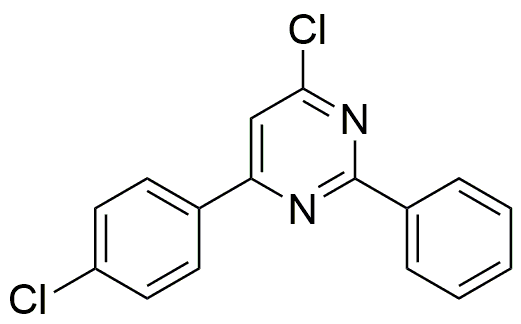4-Chloro-6-(4-chlorophenyl)-2-phenylpyrimidine is widely utilized in research focused on:
- Agricultural Chemistry: This compound serves as a key ingredient in developing herbicides, helping to control weed growth effectively while minimizing crop damage.
- Pharmaceutical Development: It is explored for its potential as an anti-cancer agent, with studies indicating its ability to inhibit specific cancer cell lines.
- Material Science: The compound is used in synthesizing advanced materials, including polymers that exhibit enhanced thermal stability and chemical resistance.
- Biochemical Research: Researchers utilize it to study enzyme inhibition, providing insights into metabolic pathways and potential therapeutic targets.
- Environmental Science: It plays a role in developing eco-friendly pesticides, aiming to reduce environmental impact while maintaining agricultural productivity.
General Information
Properties
Safety and Regulations
Applications
4-Chloro-6-(4-chlorophenyl)-2-phenylpyrimidine is widely utilized in research focused on:
- Agricultural Chemistry: This compound serves as a key ingredient in developing herbicides, helping to control weed growth effectively while minimizing crop damage.
- Pharmaceutical Development: It is explored for its potential as an anti-cancer agent, with studies indicating its ability to inhibit specific cancer cell lines.
- Material Science: The compound is used in synthesizing advanced materials, including polymers that exhibit enhanced thermal stability and chemical resistance.
- Biochemical Research: Researchers utilize it to study enzyme inhibition, providing insights into metabolic pathways and potential therapeutic targets.
- Environmental Science: It plays a role in developing eco-friendly pesticides, aiming to reduce environmental impact while maintaining agricultural productivity.
Documents
Safety Data Sheets (SDS)
The SDS provides comprehensive safety information on handling, storage, and disposal of the product.
Product Specification (PS)
The PS provides a comprehensive breakdown of the product’s properties, including chemical composition, physical state, purity, and storage requirements. It also details acceptable quality ranges and the product's intended applications.
Certificates of Analysis (COA)
Search for Certificates of Analysis (COA) by entering the products Lot Number. Lot and Batch Numbers can be found on a product’s label following the words ‘Lot’ or ‘Batch’.
*Catalog Number
*Lot Number
Certificates Of Origin (COO)
This COO confirms the country where the product was manufactured, and also details the materials and components used in it and whether it is derived from natural, synthetic, or other specific sources. This certificate may be required for customs, trade, and regulatory compliance.
*Catalog Number
*Lot Number
Safety Data Sheets (SDS)
The SDS provides comprehensive safety information on handling, storage, and disposal of the product.
DownloadProduct Specification (PS)
The PS provides a comprehensive breakdown of the product’s properties, including chemical composition, physical state, purity, and storage requirements. It also details acceptable quality ranges and the product's intended applications.
DownloadCertificates of Analysis (COA)
Search for Certificates of Analysis (COA) by entering the products Lot Number. Lot and Batch Numbers can be found on a product’s label following the words ‘Lot’ or ‘Batch’.
*Catalog Number
*Lot Number
Certificates Of Origin (COO)
This COO confirms the country where the product was manufactured, and also details the materials and components used in it and whether it is derived from natural, synthetic, or other specific sources. This certificate may be required for customs, trade, and regulatory compliance.


